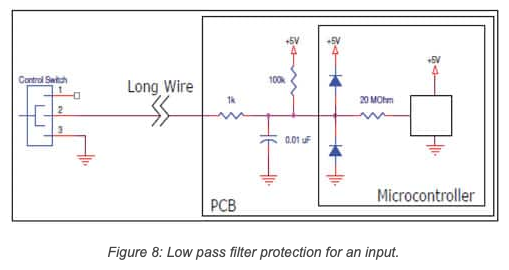Hi All,
I am trying to use the small Cubecell board (AB01) for a rain gauge but getting random, phantom counts for some reason.
Hardware
- Davis tipping bucket rain gauge with two wires, one connected to ground and the other to GPIO0.
Software
- sketch attached below
- it uses a combination of the example LoRaWAN and Interrupt sketches.
- Rain Gauge reed switch is debounced
- GPIO0 is set as a pullup
- It counts interrupts while asleep and then wakes up at a set interval to send the count.
Unusual Behaviour
- Rain gauge will run for days without any issues and then all of a sudden register a few interrupts for no reason (rain gauge is sitting on a bench in a locked office, so no chance of it being bumped), and then register nothing for another few days, and then have a random interrupt count again.
What I have tried
- I have tried using an external pullup resistor (10K and then 20K - GPIO0 to VDD) but it still happens.
-also tried several boards, same thing happens
Any ideas would be greatly appreciated.
thanks Paul
/*For a Davis Rain Gauge
* Red Wire to GPIO0 (interrupt attached)
* Green wire to Ground
* interrupt works on falling (pulling to GND)
* Rain Guage tipping bucket is debounced with 200ms time out
* Downlink format - send one byte to change send interval = 'byte sent value' X 'txMultiplier'
*/
#include "LoRaWan_APP.h"
#include "Arduino.h"
/*
* set LoraWan_RGB to Active,the RGB active in loraWan
* RGB red means sending;
* RGB purple means joined done;
* RGB blue means RxWindow1;
* RGB yellow means RxWindow2;
* RGB green means received done;
*/
/*the application data transmission duty cycle. value in [ms].*/
uint32_t appTxDutyCycle = 600000; // Default 10 mins
uint32_t txMultiplier = 300000; //Multiplier used for downlink
#define rainPin GPIO0
int rain = 0;
uint16_t vbat;
/* OTAA para*/
uint8_t devEui[] = { };
//generic_meshed_testing app
uint8_t appEui[] = { };
uint8_t appKey[] = { };
/* ABP para*/
uint8_t nwkSKey[] = { };
uint8_t appSKey[] = { };
uint32_t devAddr = ( uint32_t );
/*LoraWan channelsmask, default channels 0-7 - 0xFF00 sets to sub band 2 */
uint16_t userChannelsMask[6]={ 0xFF00, 0x0000, 0x0000, 0x0000, 0x0000, 0x0000};
/*LoraWan region, select in arduino IDE tools*/
LoRaMacRegion_t loraWanRegion = ACTIVE_REGION;
/*LoraWan Class, Class A and Class C are supported*/
DeviceClass_t loraWanClass = LORAWAN_CLASS;
/*OTAA or ABP*/
bool overTheAirActivation = LORAWAN_NETMODE;
/*ADR enable*/
bool loraWanAdr = LORAWAN_ADR;
/* set LORAWAN_Net_Reserve ON, the node could save the network info to flash, when node reset not need to join again */
bool keepNet = LORAWAN_NET_RESERVE;
/* Indicates if the node is sending confirmed or unconfirmed messages */
bool isTxConfirmed = LORAWAN_UPLINKMODE;
/* Application port */
uint8_t appPort = 1;
/* Note, that if NbTrials is set to 1 or 2, the MAC will not decrease
* the datarate, in case the LoRaMAC layer did not receive an acknowledgment
*/
uint8_t confirmedNbTrials = 4;
/* Prepares the payload of the frame */
static void prepareTxFrame( uint8_t port )
{
uint16_t vbat = getBatteryVoltage();
Serial.println("");
Serial.println("");
Serial.println("");
Serial.print("Vbat = ");Serial.println(vbat);
Serial.print("Rain = ");Serial.println(rain);
appDataSize = 4;//AppDataSize max value is 64
appData[0] = highByte(vbat);
appData[1] = lowByte(vbat);
appData[2] = highByte(rain);
appData[3] = lowByte(rain);
}
void setup() {
boardInitMcu();
Serial.begin(115200);
#if(AT_SUPPORT)
enableAt();
#endif
deviceState = DEVICE_STATE_INIT;
LoRaWAN.ifskipjoin();
pinMode(rainPin,INPUT_PULLUP);
attachInterrupt(rainPin,raincounter,FALLING);
}
void loop()
{
switch( deviceState )
{
case DEVICE_STATE_INIT:
{
#if(AT_SUPPORT)
getDevParam();
#endif
printDevParam();
LoRaWAN.init(loraWanClass,loraWanRegion);
deviceState = DEVICE_STATE_JOIN;
break;
}
case DEVICE_STATE_JOIN:
{
LoRaWAN.join();
break;
}
case DEVICE_STATE_SEND:
{
prepareTxFrame( appPort );
LoRaWAN.send();
deviceState = DEVICE_STATE_CYCLE;
break;
}
case DEVICE_STATE_CYCLE:
{
// Schedule next packet transmission
txDutyCycleTime = appTxDutyCycle + randr( 0, APP_TX_DUTYCYCLE_RND );
LoRaWAN.cycle(txDutyCycleTime);
deviceState = DEVICE_STATE_SLEEP;
break;
}
case DEVICE_STATE_SLEEP:
{
LoRaWAN.sleep();
break;
}
default:
{
deviceState = DEVICE_STATE_INIT;
break;
}
}
}
void raincounter() {
//Debounce switch
static unsigned long last_interrupt_time = 0;
unsigned long interrupt_time = millis();
// If interrupts come faster than 200ms, assume it's a bounce and ignore
if (interrupt_time - last_interrupt_time > 200)
{
rain = rain + 1;
}
last_interrupt_time = interrupt_time;
}
//downlink data handle function
void downLinkDataHandle(McpsIndication_t *mcpsIndication)
{
Serial.printf("+REV DATA:%s,RXSIZE %d,PORT %d\r\n",mcpsIndication->RxSlot?"RXWIN2":"RXWIN1",mcpsIndication->BufferSize,mcpsIndication->Port);
Serial.print("+REV DATA:");
for(uint8_t i=0;i<mcpsIndication->BufferSize;i++) {
Serial.printf("%02X",mcpsIndication->Buffer[i]);
}
Serial.println();
if (mcpsIndication->BufferSize == 1) {
Serial.println("Check 1 Byte Message");
appTxDutyCycle = (mcpsIndication->Buffer[0])*txMultiplier;
Serial.print("Changing TX Interval to: ");Serial.print(appTxDutyCycle/60000);Serial.println(" mins");
}
}
